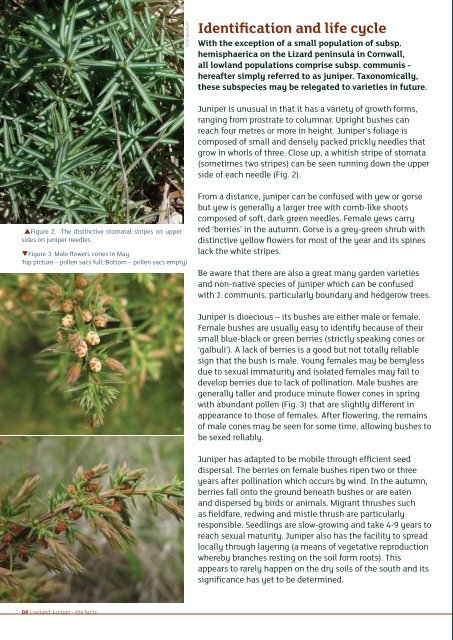Breaking new ground for juniper - Plantlife
Breaking new ground for juniper - Plantlife
Breaking new ground for juniper - Plantlife
- No tags were found...
Create successful ePaper yourself
Turn your PDF publications into a flip-book with our unique Google optimized e-Paper software.
Figure 2. The distinctive stomatal stripes on uppersides on <strong>juniper</strong> needles.Figure 3. Male flowers cones in MayTop picture – pollen sacs full; Bottom – pollen sacs empty)08 Lowland Juniper - the facts© Pat WoodruffeIdentification and life cycleWith the exception of a small population of subsp.hemisphaerica on the Lizard peninsula in Cornwall,all lowland populations comprise subsp. communis -hereafter simply referred to as <strong>juniper</strong>. Taxonomically,these subspecies may be relegated to varieties in future.Juniper is unusual in that it has a variety of growth <strong>for</strong>ms,ranging from prostrate to columnar. Upright bushes canreach four metres or more in height. Juniper’s foliage iscomposed of small and densely packed prickly needles thatgrow in whorls of three. Close up, a whitish stripe of stomata(sometimes two stripes) can be seen running down the upperside of each needle (Fig. 2).From a distance, <strong>juniper</strong> can be confused with yew or gorsebut yew is generally a larger tree with comb-like shootscomposed of soft, dark green needles. Female yews carryred ‘berries’ in the autumn. Gorse is a grey-green shrub withdistinctive yellow flowers <strong>for</strong> most of the year and its spineslack the white stripes.Be aware that there are also a great many garden varietiesand non-native species of <strong>juniper</strong> which can be confusedwith J. communis, particularly boundary and hedgerow trees.Juniper is dioecious – its bushes are either male or female.Female bushes are usually easy to identify because of theirsmall blue-black or green berries (strictly speaking cones or‘galbuli’). A lack of berries is a good but not totally reliablesign that the bush is male. Young females may be berrylessdue to sexual immaturity and isolated females may fail todevelop berries due to lack of pollination. Male bushes aregenerally taller and produce minute flower cones in springwith abundant pollen (Fig. 3) that are slightly different inappearance to those of females. After flowering, the remainsof male cones may be seen <strong>for</strong> some time, allowing bushes tobe sexed reliably.Juniper has adapted to be mobile through efficient seeddispersal. The berries on female bushes ripen two or threeyears after pollination which occurs by wind. In the autumn,berries fall onto the <strong>ground</strong> beneath bushes or are eatenand dispersed by birds or animals. Migrant thrushes suchas fieldfare, redwing and mistle thrush are particularlyresponsible. Seedlings are slow-growing and take 4-9 years toreach sexual maturity. Juniper also has the facility to spreadlocally through layering (a means of vegetative reproductionwhereby branches resting on the soil <strong>for</strong>m roots). Thisappears to rarely happen on the dry soils of the south and itssignificance has yet to be determined.Conservation challengesand solutionsAfter the last Ice Age, vast stony landscapes relatively freeof wildlife were commonplace, providing ideal conditions <strong>for</strong><strong>juniper</strong> to flourish. There have since been pulses of regenerationacross the lowlands linked to complex changes in land use. Mostrecently was in the mid-1950s, in the wake of the Myxomatosisoutbreak, when the sudden drop in rabbit numbers led to theemergence of a whole <strong>new</strong> generation of bushes. The majority of<strong>juniper</strong>s in the south today owe their existence to that event.Today’s heavily managed countrysidehas little in the way of suitable habitat<strong>for</strong> <strong>juniper</strong>. Annual cycles of grasslandmanagement conflict with its reproductivestrategy and, despite its prickly foliage,<strong>juniper</strong> is often damaged by livestock,rabbits and deer, with its seedlingsparticularly palatable.The problem is currently perpetuatedby a tendency to manage conservationgrasslands uni<strong>for</strong>mly, resulting in a paucityof bare <strong>ground</strong> and a seasonal risk ofbrowsing from livestock (Fig. 4).As lowland <strong>juniper</strong>s typically live <strong>for</strong> 100-120years, they have up to 100 opportunities toreproduce successfully. If each individual issurvived by just one offspring, a stable populationwill result. For this reason, and because of <strong>juniper</strong>’stendency to reproduce episodically, the absenceof seedlings at a site <strong>for</strong> a decade or more shouldnot be a cause <strong>for</strong> great concern. However, todaymany populations consist entirely of old collapsingbushes which are prone to sudden die-off. Urgentintervention is clearly needed at such sites.Although good berry years can produceprodigious quantities of seed, less than 2%may be viable. Combine this fact with theubiquitous threats of browsing, trampling, shade,desiccation and disease, and it becomes clearwhy seedlings are so scarce. One study showedthat out of 10,000 seeds, only 6 producedseedlings that survived their first year.Poor seed viability occurs naturally in manysmall-seeded pioneer tree species. Thesituation is, however, exacerbated by insectsLITTLE ORNO BROWSINGBARE GROUNDCONSERVATION MANAGEMENTLOWLAND CALCAREOUS GRASSLAND Figure 4. Current rarity of <strong>juniper</strong> regeneration habitatand mites that hollow out the seeds. At many<strong>juniper</strong> sites in southern England, their impactis substantial. Juniper seed can also abortduring development due to false pollinationby air pollutants or even dust. Fragmentedpopulations and biased sex ratios can furtherimpede pollination through distance or barriers.The transient nature of <strong>juniper</strong> seed means thatit fails to <strong>for</strong>m a persistent seed bank in the soil.This fact alone makes revival of lost populationsimpossible without resorting to translocation.Juniperus communis is declining in other parts oflowland Europe. Computer modelling suggests thatits European range will contract northwards as theclimate warms, implying a greater internationalresponsibility to conserve its populations inthe UK. An emerging concern in Britain, is thetrend <strong>for</strong> increasingly mild winters which mayeventually result in a failure to break seeddormancy (<strong>juniper</strong> seed requires two cold wintersto germinate). Furthermore, young seedlingsare highly susceptible to summer drought.<strong>Breaking</strong> <strong>new</strong> <strong>ground</strong> <strong>for</strong> lowland <strong>juniper</strong> 09
















